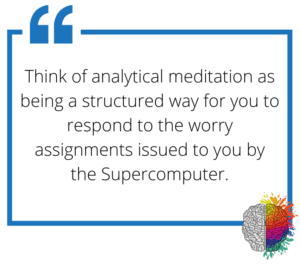Problem-Solving
A Robot's Guide To Worry Part 4:
Problem-Solving
In the previous parts of this series, we have discussed techniques to help us deal with unproductive worries. But what about situations where we don’t want to simply dismiss the things we are worrying about? Often, the issue in question does require some decision to be made, or we feel as though we do actually need to put some thought into the looming problem. In these situations, we are inclined to indulge the assignment and move with our worried thoughts. In this part of the series, we will look at a technique to help us problem-solve more effectively: analytical meditation.
For those of you who have tried mindfulness meditation in the past and found it frustrating, know that this is very different; it doesn’t feel like meditation in the traditional sense. This technique involves embracing and moving with the thoughts produced by your Unconscious Supercomputer, as opposed to trying to keep a mindful distance from them. Analytical meditation provides structure to your natural process of worry so that you can make it more productive. This technique has the added benefit of addressing the anxiety that often accompanies worry and decision-making. Think of this tool as a way to welcome the assignment and embrace the process. Before we get into the steps of analytical meditation, we will take a further look at why we worry and how the worry mechanism works.
The Adaptive Value Of the Worry Mechanism
As discussed earlier in this series, our worry response is designed to help us solve problems. When our Unconscious Supercomputer detects a potential problem looming, it will pump worried thoughts up into our consciousness. This causes our Conscious Thinking System to orient itself towards the issue and begin its work to help us prepare for the problematic situation.
A simplified version of the worry mechanism is described below. Though the actual interaction between the Supercomputer and the Conscious Thinking System is a bit more complex than what is presented here, this description will suit our purposes nicely and will provide you with an effective model to think about problem-solving. Worry begins when the Supercomputer decides that now would be a good time to request assistance from the Conscious Thinking System to help with a looming issue. This often happens when your Conscious Thinking System is not otherwise wrapped up in a pressing task. You likely have noticed that it is during downtime that your mind begins to churn and worry. It’s as if the Supercomputer is saying, “Hey Conscious Thinking System, since you’re not busy with anything else, why don’t you put that fancy processor of yours to good use and troubleshoot this situation that could potentially go wrong.” 
The Supercomputer issues its assignment by pushing worried thoughts up into consciousness. These thoughts often involve things that could potentially go wrong, as well as possible courses of action that could be taken to prevent or lessen these negative outcomes. Next, your Conscious Thinking System kicks into gear and starts taking these raw materials provided by the Supercomputer and assembling them into hypothetical scenarios. In this way, think of the Supercomputer as the idea generator and the Conscious Thinking System as the idea tester. Your Conscious Thinking System does this by imagining what these different ideas might look like and playing them out in your mind. By creating this virtual simulation, you are able to assess and test the possible effectiveness of a given course of action.
Interestingly, it is then the Supercomputer that makes judgments about and assigns value to the various potential outcomes. Then the process loops around. The Supercomputer starts generating further ideas to be incorporated into the different scenarios that the Conscious Thinking System is creating. The two systems are in constant communication and are working in cycles of back-and-forth processing to help you figure out the best way forward.
To summarize: the Supercomputer generates ideas; the Conscious Thinking System imagines how the ideas might play out and helps to analyze them; the Supercomputer makes judgments about which imagined outcome is best and plays a big role in the final decision. (For more on the role of the Supercomputer in assigning value and decision-making, see Who’s In Charge?)
This problem-solving system is quite effective, but there are a few different ways it can go awry. An obvious example is the case of unproductive worry, as covered in the previous parts of the series. In this part of our guide, we are going to look at a few ways that our productive worries can get thrown off. Sometimes, despite a situation calling for some level of worry, we find ourselves thinking about it too much. In other instances, we have the opposite problem. We know that we should be putting more thought into a looming issue, but our anxiety keeps us from starting to think about it. To help us in these situations, and in problem-solving in general, we are going to look at a way to worry better: analytical meditation.
Analytical Meditation
Analytical meditation, like mindfulness meditation, has its roots in various eastern traditions. Analytical meditation can be used for a wide variety of purposes. The version presented here is adapted specifically to help you work through the potentially problematic situations that cause you to worry. Think of analytical meditation as being a structured way for you to respond to the worry assignments issued to you by the Supercomputer. By using this structure and by understanding the worry mechanism presented above, you will be better able to decide which worries are potentially productive and how long you should indulge them prior to giving things a rest and moving on with your day. 
Analytical meditation can be done formally or on-the-fly. It is nice to engage with analytical meditation in its full form; however, do not hesitate to use this technique less formally. This can be especially useful as you move through your day and find yourself in situations where you are inclined towards mind wandering and worry, such as when you are driving, lying in bed at night, or in a waiting room. At these times, drop briefly into analytical meditation mode and get your mind to work.
The version of analytical meditation presented below has three phases. As you read through the description, do not get hung up trying to understand exactly what each phase should look like. This process is flexible, and you will create a routine based on what feels natural and works for you. After the description of the phases, we will discuss a few key points. These will help you understand what is essential in this process.
Phase 1 - Listening
If you are sitting down for a formal analytical meditation session, choose a duration and set a timer. Next, come up with a starting point: a question that represents the challenge at hand. This question could either cover the problem in its entirety or represent one particular aspect of the larger issue.
Begin the Listening Phase by bringing your attention towards your chosen question. Repeat it to yourself. Allow your mind to sit with it. Observe it. This encourages your Unconscious Supercomputer to begin working on the issue. Different thoughts related to your chosen question will begin to pop-up. We refer to this phase as “listening” because we are paying attention to what is surfacing. Observe and then allow your mind to wander and move freely.
As you sit and listen, you will find that you latch on to certain ideas and begin to consciously work on them. As this happens, imagine that there is a thread that connects one thought to the next. You will naturally begin following a particular thread. As you do, you will be entering Phase 2: Processing.
Don’t overthink the Listening Phase. You are not waiting for the clouds to part and brilliance to appear. You are simply opening your mind, observing what pops up, and allowing things to move in a direction that engages you. Sometimes, you will find yourself quickly transitioning into Phase 2, as your mind naturally begins to explore a new thread. Other times, you will find yourself frequently moving in between Phases 1 and 2, as you briefly explore then abandon various threads of thought. And still other times, you will find yourself hovering in the Listening Phase for a long while. This is fine. If nothing grabs you, so be it. This process takes time. Think of the listening phase as home base, a destination to which you will return throughout the analytical meditation process.
Phase 2 - Processing
You shift into the Processing Phase as you find yourself naturally following a thread of thought. In many of your analytical meditation sessions, you will find that most of your time will be spent in this phase. One of the main purposes here is to generate new ideas, options, and strategies. In this phase, we continue to observe the thoughts that come bubbling up, but now we are connecting them to other ideas, building hypothetical scenarios, and deliberately analyzing the various conclusions we are coming up with.
You should engage in this process of conscious analysis in whatever way feels right. You already do this all the time, so just go with what comes naturally to you. Some examples of how you might go about this include the following:
- Investigate the pros and cons of the different courses of action that occur to you.
- Examine the logic behind your conclusions and intuitions.
- Observe the emotions that are popping up; these are powerful sources of information.
- Consider the direction your gut instinct is pushing you in.
- Attempt to explore different perspectives. How would other people you know handle this situation?
- Allow your mind to wander to memories of past experiences to see how they might relate to your current ideas.
When you have explored a particular thread as far as you would like, return to Phase 1 and listen for the next thread you will follow.
Phase 3 - Resolution
The ultimate goal of this meditation is to help us resolve some problem in our lives, so at some point, we push for resolution. As you consider different courses of action during the Processing Phase, you will come upon some potential solutions that stand out. You might find that a certain solution makes the most sense or just feels right.
When you think it may be time, move to Phase 3 and shift into decision-making mode. Ask yourself: Have I done enough processing? Am I ready to move forward? Am I prepared to say this is what I’m doing and stick with it? Is it time to officially consider this issue resolved? If you’re not sure or the answer is no, return to Phase 1 or 2 and allow your ideas to start flowing and processing once again.
Mindful Problem-Solving
The above is a rough outline of this particular type of analytical meditation. You might be thinking that this process is quite similar to what you already do when problem-solving. Thinking in terms of performing an analytical meditation has benefits that you might not get from naturally engaging in a similar process. Being deliberate in how and when you perform your analytical meditation and being mindful of which phase you are in will help you to problem-solve more efficiently and spend less time spinning your wheels; more on this in the key points below.
Key Point 1 - Be Patient, Allow Uncertainty
Problem-solving is a mechanical operation; your Supercomputer and Conscious Thinking System need time to go back and forth and process all the relevant information. If you have the luxury of time before a given issue needs to be resolved, be patient with yourself. Give your brain the time to do its thing. One of the biggest impediments to this is our inherent dislike of uncertainty. We naturally want to push for resolution as quickly as possible. For less important decisions, it is often best to be decisive and move forward quickly. However, when it comes to important issues, practice sitting with uncertainty. Allow your brain to work its magic. 
If the issue is not urgent, don’t press needlessly hard for resolution. Many of your analytical meditation sessions will never move past the Processing Phase. This is normal and to be expected. When dealing with complex issues and decisions, we typically need to engage in an incremental process. Each time we sit, we advance our thinking on the subject a bit.
Though our Conscious Thinking System plays an important role in resolution, we must remember that much of the decision-making process is based upon the judgments and evaluations of the Supercomputer (for more on this, see Who’s In Charge?). Sometimes, what is preventing us from reaching resolution is not lack of effort by the Conscious Thinking System. Sometimes, what we need for resolution is further processing by the Supercomputer. In these instances, it is best to give things a rest and come back to the problem later.
Hence, if your session of analytical meditation has not produced resolution, no worries. Know that your Supercomputer will continue to work on the problem as you move through your day and even while you sleep. In fact, a lot of important processing happens while we sleep. Many of you will be familiar with the expression “sleep on it” for when you are wrestling with a difficult decision. There is a large body of scientific research to support the effectiveness of this bit of folk wisdom. After waking, you will have new ideas, opinions, and feelings available to help you get to resolution. Once your unconscious brain has had the opportunity to integrate all the new thoughts and information overnight, there even exists the possibility that you will see the issue in a fundamentally different way. Relax and give your brain space to do its thing.
Further, there are instances where final resolution is not even on the table. In these situations, the decision can’t or shouldn’t be made until you get to some critical juncture in the future. At these times, our analytical meditation simply serves to help us further prepare for the event to come. Here, it is particularly important to be okay with uncertainty. You can’t solve the issue until it’s time; give it a little thought, then leave it alone. Trust your Supercomputer. It will handle things when you get there.
Key Point 2 - Separate Processing From Resolution
The Processing Phase (where we openly consider and analyze) naturally runs into the Resolution Phase (where we push for a decision); however, it is very important to keep these phases separate. This helps to insulate the effectiveness of your processing and idea generation from the stifling effect of anxiety that so often accompanies decision-making. We all know what it is like to procrastinate on trying to resolve difficult issues because the very thought of working on them makes us cringe. This is particularly the case when there is no good course of action available to us. So often, life presents us with problems where we must pick amongst several bad alternatives. In these instances, there is no positive way forward. No matter what, someone is going to be disappointed.
In these situations, the anxiety associated with making the decision is overwhelming and makes it difficult to even begin thinking about the issue. You can help alleviate this barrier to problem-solving by clearly separating these two phases. When you are in the Processing Phase, remind yourself frequently that you are not currently in decision mode. There is no pressure right now. You are not pushing for resolution. At this moment, you are simply engaged in a neutral, meditative process that allows your brain to do the necessary work that is a precursor to later phases. That is all.
When processing, you don’t want your fear of certain situations to restrict the free flow of ideas. In this phase, nothing is off-limits. Allow your brain to process and consider a wide range of options. No idea is too big or too scary. Remind yourself that you are not seriously considering these more off-the-wall solutions. You are not seriously considering anything right now. Processing these bold possibilities is a means to an end. These ideas will trigger other ideas. Allow things to evolve and flow. 
Your brain is a mechanical system, allow the mechanical work to take place that is required to come up with creative and well-thought-out plans of action. Later, there will be a time to grit your teeth and push for resolution and action; for now, relax and let your Conscious Thinking System and Supercomputer flow back and forth.
No one enjoys these difficult situations where there will be no good outcome; however, they are made worse if you have trouble even bringing yourself to think about them. By separating process from resolution, you can get the ball rolling and allow your powerful brain to begin doing its job. Have faith in yourself that you will effectively deal with the decision and action phases when it is time. Your Supercomputer will help you when you get there; it is more powerful than you realize. For now, allow your brain to process any way it would like, sleep on it, and return again tomorrow. There is genius deep inside you. Allow it to surface.
Key Point 3 - Worry Time
There is a technique that many people find helpful called worry time. It is particularly useful for those of us who worry too much in general. The idea of worry time is that you set aside a certain period of time to worry, ideally scheduled for the same time each day to help make it a habit. A common duration is 15 minutes. During this time, you allow yourself to indulge all of your impulses to worry and fret about whatever has been on your mind that day.
At any other time during the day, when you find that your Supercomputer has pumped another worried thought up into your conscious mind, tell yourself that you are going to postpone taking on this assignment until you get to worry time. Feel free to write down this particular worry and add it to a list, one that you will review during worry time. This act can help your mind let go, knowing that you will return to this matter later.
A session of analytical meditation can work in a similar way. When dealing with a worry that is not clearly unproductive but yet seems excessive, it can be helpful to briefly drop into a timed session of analytical meditation. Once the timer rings, acknowledge that you have put in the work and have honored the assignment issued to you by your unconscious brain. You have now considered this issue enough for today. Whatever the outcome of this analytical meditation, you can take comfort in knowing that your Supercomputer will continue working on the problem in the background.
Now move forward with your life, fully engage with the next activity in your day, and know that your unconscious brain will have a fresh perspective once it has slept on this again. If you find yourself starting to worry about the issue again, postpone the worry and remind yourself that now is not the time; there is nothing more to be done consciously for now. Tell yourself that you can address this worry again tomorrow with another analytical meditation should you so choose.
Onward
Analytical meditation is a powerful technique that gains strength when combined with an understanding of the role of unconscious processing in problem-solving. This combination helps you to make better decisions and spend your mental resources more wisely. In the next part of this series, we will look at another technique that will further enhance your natural problem-solving and decision-making abilities.
